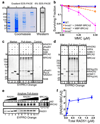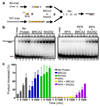Purified human BRCA2 stimulates RAD51-mediated recombination
- PMID: 20729832
- PMCID: PMC2952063
- DOI: 10.1038/nature09399
Purified human BRCA2 stimulates RAD51-mediated recombination
Abstract
Mutation of the breast cancer susceptibility gene, BRCA2, leads to breast and ovarian cancers. Mechanistic insight into the functions of human BRCA2 has been limited by the difficulty of isolating this large protein (3,418 amino acids). Here we report the purification of full-length BRCA2 and show that it both binds RAD51 and potentiates recombinational DNA repair by promoting assembly of RAD51 onto single-stranded DNA (ssDNA). BRCA2 acts by targeting RAD51 to ssDNA over double-stranded DNA, enabling RAD51 to displace replication protein-A (RPA) from ssDNA and stabilizing RAD51-ssDNA filaments by blocking ATP hydrolysis. BRCA2 does not anneal ssDNA complexed with RPA, implying it does not directly function in repair processes that involve ssDNA annealing. Our findings show that BRCA2 is a key mediator of homologous recombination, and they provide a molecular basis for understanding how this DNA repair process is disrupted by BRCA2 mutations, which lead to chromosomal instability and cancer.
Figures

 ), brca2−/− + MBP-BRCA2 (
), brca2−/− + MBP-BRCA2 ( ), 2XMBP-BRCA2 (
), 2XMBP-BRCA2 ( ), and brca2−/− VC8 (
), and brca2−/− VC8 ( ) cells. Errors bars, s.d. (n=3). (c) and (d) Protein pull-downs. 2XMBP-BRCA2 with indicated proteins. “Marker”, protein input. ”Control”, proteins + amylose resin. (e) RAD51 titration of BRCA2: Lanes 1–4, RAD51 standards; 5–11, Pull-downs; 5, BRCA2 alone; 11, RAD51 alone; 12–14, BRCA2 standards. (f) Data from (e) fit to segmental linear regression. Errors bars, s.d. (n=2).
) cells. Errors bars, s.d. (n=3). (c) and (d) Protein pull-downs. 2XMBP-BRCA2 with indicated proteins. “Marker”, protein input. ”Control”, proteins + amylose resin. (e) RAD51 titration of BRCA2: Lanes 1–4, RAD51 standards; 5–11, Pull-downs; 5, BRCA2 alone; 11, RAD51 alone; 12–14, BRCA2 standards. (f) Data from (e) fit to segmental linear regression. Errors bars, s.d. (n=2).
 ), 5’ Tailed DNA (
), 5’ Tailed DNA ( ), ssDNA (
), ssDNA ( ), and dsDNA (
), and dsDNA ( ). (c) EMSA in 0.5 M or 1 M NaCl: 3’ tailed (squares) or ssDNA (circles). Error bars, s.d. (n=3).
). (c) EMSA in 0.5 M or 1 M NaCl: 3’ tailed (squares) or ssDNA (circles). Error bars, s.d. (n=3).
 ); presence (
); presence ( ) of RPA. Error bars, s.d. (n=3). (d) DNA strand exchange protocol for (e) in absence of RPA. (e) Quantification of (d).
) of RPA. Error bars, s.d. (n=3). (d) DNA strand exchange protocol for (e) in absence of RPA. (e) Quantification of (d).

Comment in
-
DNA repair: A protein giant in its entirety.Nature. 2010 Oct 7;467(7316):667-8. doi: 10.1038/467667a. Nature. 2010. PMID: 20930833 No abstract available.
References
-
- Lengauer C, Kinzler KW, Vogelstein B. Genetic instabilities in human cancers. Nature. 1998;396:643–649. - PubMed
-
- Wooster R, et al. Identification of the breast cancer susceptibility gene BRCA2. Nature. 1995;378:789–792. - PubMed
-
- Phelan CM, et al. Mutation analysis of the BRCA2 gene in 49 site-specific breast cancer families. Nat. Genet. 1996;13:120–122. - PubMed
-
- Wong AKC, Pero R, Ormonde PA, Tavtigian SV, Bartel PL. RAD51 interacts with the evolutionarily conserved BRC motifs in the human breast cancer susceptibility gene brca2. J. Biol. Chem. 1997;272:31941–31944. - PubMed
Publication types
MeSH terms
Substances
Grants and funding
LinkOut - more resources
Full Text Sources
Molecular Biology Databases
Research Materials
Miscellaneous

